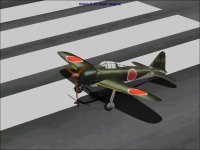Practice with the Stirling
I spent a bit more time over the last couple days (between other projects) editing the flight model of the Stirling.
Very early on, I found that substituting the Propeller Power Coefficient Table (Record 512) from the Spitfire Mk.I made a great improvement in general flight performance. The last Table was from the Hurricane Mk.I and while it let the engine achieve full RPM very fast unlike the original one which was probably from the P-51D, its power coefficient numbers were probably a bit too low.
The attached screenshot shows that with proper technique, it is possible to Take-Off even from the little Island Airstrip with full fuel AND a reasonable bomb load.
In this picture, the Zero Fuel Weight of the Stirling is 49,900 pounds so....
49,900 pounds - Aircraft
962.5 pounds - MG Ammunition - 14,000 rounds of .303
16,224 pounds - 2704 US Gallons in fixed Fuel Tanks
4000 pounds - 8 x 8000 ounce (500 pound) Bombs
---------------
71,086.5 pounds Take-Off Weight.
Two notches of Flaps,
Engines need to be held against the Brakes until they reach their maximum RPM (about 2350 RPM with no forward speed).
Acceleration once airborne is VERY slow and there is pretty much no margin for errors.
- Ivan.
I spent a bit more time over the last couple days (between other projects) editing the flight model of the Stirling.
Very early on, I found that substituting the Propeller Power Coefficient Table (Record 512) from the Spitfire Mk.I made a great improvement in general flight performance. The last Table was from the Hurricane Mk.I and while it let the engine achieve full RPM very fast unlike the original one which was probably from the P-51D, its power coefficient numbers were probably a bit too low.
The attached screenshot shows that with proper technique, it is possible to Take-Off even from the little Island Airstrip with full fuel AND a reasonable bomb load.
In this picture, the Zero Fuel Weight of the Stirling is 49,900 pounds so....
49,900 pounds - Aircraft
962.5 pounds - MG Ammunition - 14,000 rounds of .303
16,224 pounds - 2704 US Gallons in fixed Fuel Tanks
4000 pounds - 8 x 8000 ounce (500 pound) Bombs
---------------
71,086.5 pounds Take-Off Weight.
Two notches of Flaps,
Engines need to be held against the Brakes until they reach their maximum RPM (about 2350 RPM with no forward speed).
Acceleration once airborne is VERY slow and there is pretty much no margin for errors.
- Ivan.






